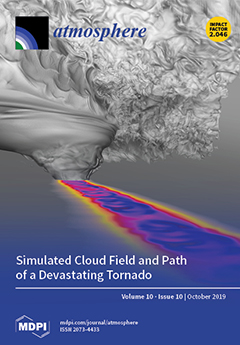Studying the presence of aerosols in different atmospheric layers helps researchers understand their impacts on climate change, air quality, and human health. Therefore, in the present study, the optical and physical properties of aerosol layers over the Yellow River Basin (YERB) were investigated using the CALIPSO Level 2 aerosol layer products from January 2007 to December 2014. The Yellow River Basin was divided into three sub-regions i.e., YERB
1 (the plain region downstream of the YERB), YERB
2 (the Loess Plateau region in the middle reaches of the YERB), and YERB
3 (the mountainous terrain in the upper reaches of the YERB). The results showed that the amount (number) of aerosol layers (N) was relatively large (>2 layers) in the lower part of the YERB (YERB
1), which was mainly caused by atmospheric convection. The height of the highest aerosol layer top (HT
H) and the height of the lowest aerosol layers base (HB
1) varied significantly with respect to the topography of the YERB. High and low values of aerosol optical depth (AOD) were observed over the YERB
1 (plain area) and YERB
3 (elevated area) regions, respectively. Population, economy, and agricultural activities might be the possible reasons for spatial variations in AOD. AOD values for the lowest aerosol layer were high—between 0.7 and 1.0 throughout the year—indicating that aerosols were mainly concentrated at the bottom layer of the atmosphere. In addition, the integrated volume depolarization ratio (0.15–0.2) and the integrated attenuated total color ratio (~0.1) were large during spring for the lowest aerosol layer due to the presence of dust aerosols. The thicknesses of the lowest aerosol layers (TL
1) did not vary with respect to the topographic features of the YERB. Over the sub-regions of the YERB, a significant positive correlation between the AOD of the lowest aerosol layer (AOD
1) and the thickness of the lowest aerosol layer (TL
1) was found, which indicates that TL
1 increases with the increase of AOD
1. In the whole YERB, a positive linear correlation between the N and HT
H was observed, whereas a negative correlation between N and the portion of AOD for the lowest aerosol layer (PAOD
1) was found, which revealed that the large value of N leads to the small value of PAOD
1. The results from the present study will be helpful to further investigate the aerosol behavior and their impacts on climate change, air quality, and human health over the YERB.
Full article





